HiSET Science Practice Test
Our HiSET Science practice test will help you prepare for this section of the test. There are 50 multiple choice questions on the HiSET Science test which must be answered within 80 minutes. Most of the questions include an exhibit with an image, chart, or text passage. Be sure to review the exhibit carefully before selecting your answer.
Quiz Summary
0 of 22 Questions completed
Questions:
Information
You have already completed the quiz before. Hence you can not start it again.
Quiz is loading…
You must sign in or sign up to start the quiz.
You must first complete the following:
Results
Results
0 of 22 Questions answered correctly
Your time:
Time has elapsed
You have reached 0 of 0 point(s), (0)
Earned Point(s): 0 of 0, (0)
0 Essay(s) Pending (Possible Point(s): 0)
Categories
- Not categorized 0%
-
Question 1 of 22
1. Question
Use the following information to answer questions 1–3:
A sample of Robin and Snow Owl populations in Wisconsin for a given year is shown below: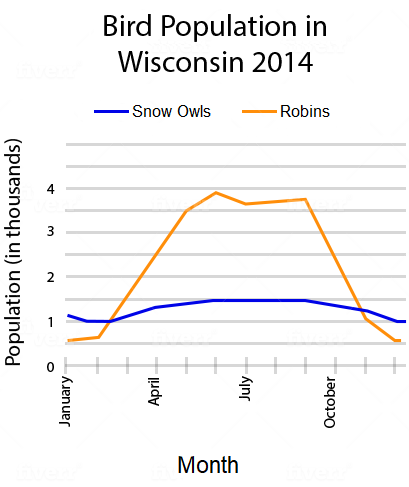
Which of the following is correct?
CorrectIncorrect -
Question 2 of 22
2. Question
A sample of Robin and Snow Owl populations in Wisconsin for a given year is shown below:
What conclusion can we draw from the graph?
CorrectIncorrect -
Question 3 of 22
3. Question
A sample of Robin and Snow Owl populations in Wisconsin for a given year is shown below:
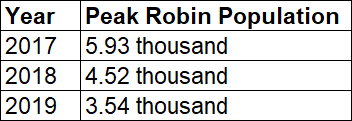
The peak Robin population for three different years is shown in the table above. When the average for these three years is calculated, the raw result is 4.663333 thousand. What should be recorded as the average population?
CorrectIncorrect -
Question 4 of 22
4. Question
As part of a study on how skin tone and redness correlate when exposed to different amounts of UV light, a scientist set up an experiment to see how much redness occurred on various skin tones. The scientist classified 100 people into six different categories of skin tone, then exposed them to increasingly higher doses of UV light and recorded the level of redness that appeared on the skin.Which is an independent variable and which is a dependent variable in this experiment?
CorrectIncorrect -
Question 5 of 22
5. Question
Questions 5–8 are based on the following table.
This table contains data from the National Centers for Environmental Information. It displays the average temperature in the United States at five-year intervals from 1920 to 2015.
A change of 0.2°F or more in a 5-year period is considered significant. A change of 1.0°F or more in a 5-year period is considered extreme.
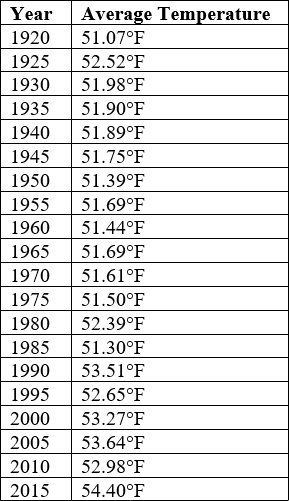
Which of the following statements best describes the trends in the data above?
CorrectIncorrect -
Question 6 of 22
6. Question
This table contains data from the National Centers for Environmental Information. It displays the average temperature in the United States at five-year intervals from 1920 to 2015.
A change of 0.2°F or more in a 5-year period is considered significant. A change of 1.0°F or more in a 5-year period is considered extreme.

Which pair of years had the smallest change in temperature, according to this data?
CorrectIncorrect -
Question 7 of 22
7. Question
This table contains data from the National Centers for Environmental Information. It displays the average temperature in the United States at five-year intervals from 1920 to 2015.
A change of 0.2°F or more in a 5-year period is considered significant. A change of 1.0°F or more in a 5-year period is considered extreme.

Which statement is true about the years 2010 and 2015?
CorrectIncorrect -
Question 8 of 22
8. Question
This table contains data from the National Centers for Environmental Information. It displays the average temperature in the United States at five-year intervals from 1920 to 2015.
A change of 0.2°F or more in a 5-year period is considered significant. A change of 1.0°F or more in a 5-year period is considered extreme.

Does this data suggest that climate has changed in the last century?
CorrectIncorrect -
Question 9 of 22
9. Question
Questions 9–11 are based on the following information.
In the 21st century, worker bees in bee colonies have been abandoning their queens and are deserting their hives in record numbers. Known as Colony Collapse Disorder, honeybees have been mysteriously disappearing across the planet—and one area that has been seriously affected is California’s Napa Valley. This issue became more commonly known when The National Agriculture Statistics Service reported in 2008 that only 2.44 million honey-producing hives were in the United States, down from 4.5 million in 1980.There is no consensus among scientists as to what is causing Colony Collapse Disorder, though the USDA has undertaken a plan of action to stem the collapsing colonies involving several steps: survey and data collection, analysis of samples, hypothesis-driven research, and mitigation and preventive action. The first findings from the USDA were published in 2009 and suggested that factors such as pesticides, parasites, and pathogens may be possible causes, all of which have affected hives in Northern California.
One researcher has hypothesized that chemical pesticides are solely responsible for Colony Collapse Disorder in Napa Valley. To test his hypothesis, he is planning to run an experiment. He has obtained several healthy bee colonies and plans to expose them to pesticides while measuring the health of the colonies.
Which additional information would be the most useful in helping him design this experiment?
CorrectIncorrect -
Question 10 of 22
10. Question
In the 21st century, worker bees in bee colonies have been abandoning their queens and are deserting their hives in record numbers. Known as Colony Collapse Disorder, honeybees have been mysteriously disappearing across the planet—and one area that has been seriously affected is California’s Napa Valley. This issue became more commonly known when The National Agriculture Statistics Service reported in 2008 that only 2.44 million honey-producing hives were in the United States, down from 4.5 million in 1980.There is no consensus among scientists as to what is causing Colony Collapse Disorder, though the USDA has undertaken a plan of action to stem the collapsing colonies involving several steps: survey and data collection, analysis of samples, hypothesis-driven research, and mitigation and preventive action. The first findings from the USDA were published in 2009 and suggested that factors such as pesticides, parasites, and pathogens may be possible causes, all of which have affected hives in Northern California.
One researcher has hypothesized that chemical pesticides are solely responsible for Colony Collapse Disorder in Napa Valley. To test his hypothesis, he is planning to run an experiment. He has obtained several healthy bee colonies and plans to expose them to pesticides while measuring the health of the colonies.
Suppose that his experiment finds that the pesticides used in Napa Valley do cause bee colonies to collapse. Over the next few years other researchers find very similar results, and these results are widely accepted as valid. At that point, the idea that pesticides cause colony collapse would be a:
CorrectIncorrect -
Question 11 of 22
11. Question
In the 21st century, worker bees in bee colonies have been abandoning their queens and are deserting their hives in record numbers. Known as Colony Collapse Disorder, honeybees have been mysteriously disappearing across the planet—and one area that has been seriously affected is California’s Napa Valley. This issue became more commonly known when The National Agriculture Statistics Service reported in 2008 that only 2.44 million honey-producing hives were in the United States, down from 4.5 million in 1980.There is no consensus among scientists as to what is causing Colony Collapse Disorder, though the USDA has undertaken a plan of action to stem the collapsing colonies involving several steps: survey and data collection, analysis of samples, hypothesis-driven research, and mitigation and preventive action. The first findings from the USDA were published in 2009 and suggested that factors such as pesticides, parasites, and pathogens may be possible causes, all of which have affected hives in Northern California.
One researcher has hypothesized that chemical pesticides are solely responsible for Colony Collapse Disorder in Napa Valley. To test his hypothesis, he is planning to run an experiment. He has obtained several healthy bee colonies and plans to expose them to pesticides while measuring the health of the colonies.
After the researcher’s experiment finds that pesticides are causing bee colonies to collapse, his assistant says, “If pesticides are causing colony collapse, then it is not being caused by parasites.” The assistant’s statement is best described as:
CorrectIncorrect -
Question 12 of 22
12. Question
Below is the chemical equation for photosynthesis:

Which of the following statements about photosynthesis is correct?
CorrectIncorrect -
Question 13 of 22
13. Question
Questions 13–18 are based on the following information.
Organic molecules (carbohydrates, proteins, nucleic acids, and lipids) are the critical building blocks of life on Earth. A challenge scientists have to reconcile is how Earth—which used to be solely rock and inorganic materials—could have suddenly produced the organic molecules critical to life.In the development of a theory to describe how life first started on Earth, a popular belief is that primordial unicellular organisms used geothermal vents in the deep for energy. These geothermal vents release very hot gases from inside the earth to the very cold water deep in the ocean. From the very hot gasses to the cold ocean, the temperature of the water slowly decreased, and there is a region where organisms could have found healthy organic compounds for energy. In this region, inorganic molecules such as ammonia, methane and hydrogen sulfide could have been used by the first unicellular organisms to synthesize new organic molecules.
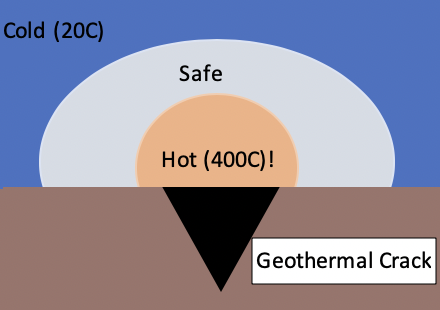
Which of the following is not an organic molecule?
CorrectIncorrect -
Question 14 of 22
14. Question
Organic molecules (carbohydrates, proteins, nucleic acids, and lipids) are the critical building blocks of life on Earth. A challenge scientists have to reconcile is how Earth—which used to be solely rock and inorganic materials—could have suddenly produced the organic molecules critical to life.In the development of a theory to describe how life first started on Earth, a popular belief is that primordial unicellular organisms used geothermal vents in the deep for energy. These geothermal vents release very hot gases from inside the earth to the very cold water deep in the ocean. From the very hot gasses to the cold ocean, the temperature of the water slowly decreased, and there is a region where organisms could have found healthy organic compounds for energy. In this region, inorganic molecules such as ammonia, methane and hydrogen sulfide could have been used by the first unicellular organisms to synthesize new organic molecules.

Which of the following gases was believed to been important to organic molecule formation?
CorrectIncorrect -
Question 15 of 22
15. Question
Organic molecules (carbohydrates, proteins, nucleic acids, and lipids) are the critical building blocks of life on Earth. A challenge scientists have to reconcile is how Earth—which used to be solely rock and inorganic materials—could have suddenly produced the organic molecules critical to life.In the development of a theory to describe how life first started on Earth, a popular belief is that primordial unicellular organisms used geothermal vents in the deep for energy. These geothermal vents release very hot gases from inside the earth to the very cold water deep in the ocean. From the very hot gasses to the cold ocean, the temperature of the water slowly decreased, and there is a region where organisms could have found healthy organic compounds for energy. In this region, inorganic molecules such as ammonia, methane and hydrogen sulfide could have been used by the first unicellular organisms to synthesize new organic molecules.

Based upon this theory, what temperature would be optimal for the transitions of inorganic to organic molecules?
CorrectIncorrect -
Question 16 of 22
16. Question
Organic molecules (carbohydrates, proteins, nucleic acids, and lipids) are the critical building blocks of life on Earth. A challenge scientists have to reconcile is how Earth—which used to be solely rock and inorganic materials—could have suddenly produced the organic molecules critical to life.In the development of a theory to describe how life first started on Earth, a popular belief is that primordial unicellular organisms used geothermal vents in the deep for energy. These geothermal vents release very hot gases from inside the earth to the very cold water deep in the ocean. From the very hot gasses to the cold ocean, the temperature of the water slowly decreased, and there is a region where organisms could have found healthy organic compounds for energy. In this region, inorganic molecules such as ammonia, methane and hydrogen sulfide could have been used by the first unicellular organisms to synthesize new organic molecules.

Which of the following would be a key assumption to the geothermal vent theory of the beginning of life?
CorrectIncorrect -
Question 17 of 22
17. Question
Organic molecules (carbohydrates, proteins, nucleic acids, and lipids) are the critical building blocks of life on Earth. A challenge scientists have to reconcile is how Earth—which used to be solely rock and inorganic materials—could have suddenly produced the organic molecules critical to life.In the development of a theory to describe how life first started on Earth, a popular belief is that primordial unicellular organisms used geothermal vents in the deep for energy. These geothermal vents release very hot gases from inside the earth to the very cold water deep in the ocean. From the very hot gasses to the cold ocean, the temperature of the water slowly decreased, and there is a region where organisms could have found healthy organic compounds for energy. In this region, inorganic molecules such as ammonia, methane and hydrogen sulfide could have been used by the first unicellular organisms to synthesize new organic molecules.
 In current Biology, there are two main categories of uni-cellular life: Prokaryotes and Eukaryotes. Prokaryotes consist of Bacteria—which receive energy from either light or other organic molecules—and Archaea—which can receive energy from hydrogen sulfide. Eukaryotes can be characterized as Protozoa, algae, or fungi—all of which receive energy from either the sun or organic molecules.
In current Biology, there are two main categories of uni-cellular life: Prokaryotes and Eukaryotes. Prokaryotes consist of Bacteria—which receive energy from either light or other organic molecules—and Archaea—which can receive energy from hydrogen sulfide. Eukaryotes can be characterized as Protozoa, algae, or fungi—all of which receive energy from either the sun or organic molecules.Considering the additional information provided above, which of the following types of cellular life would most likely be found in the geothermal vent?
CorrectIncorrect -
Question 18 of 22
18. Question
Organic molecules (carbohydrates, proteins, nucleic acids, and lipids) are the critical building blocks of life on Earth. A challenge scientists have to reconcile is how Earth—which used to be solely rock and inorganic materials—could have suddenly produced the organic molecules critical to life.In the development of a theory to describe how life first started on Earth, a popular belief is that primordial unicellular organisms used geothermal vents in the deep for energy. These geothermal vents release very hot gases from inside the earth to the very cold water deep in the ocean. From the very hot gasses to the cold ocean, the temperature of the water slowly decreased, and there is a region where organisms could have found healthy organic compounds for energy. In this region, inorganic molecules such as ammonia, methane and hydrogen sulfide could have been used by the first unicellular organisms to synthesize new organic molecules.
 In current Biology, there are two main categories of uni-cellular life: Prokaryotes and Eukaryotes. Prokaryotes consist of Bacteria—which receive energy from either light or other organic molecules—and Archaea—which can receive energy from hydrogen sulfide. Eukaryotes can be characterized as Protozoa, algae, or fungi—all of which receive energy from either the sun or organic molecules.
In current Biology, there are two main categories of uni-cellular life: Prokaryotes and Eukaryotes. Prokaryotes consist of Bacteria—which receive energy from either light or other organic molecules—and Archaea—which can receive energy from hydrogen sulfide. Eukaryotes can be characterized as Protozoa, algae, or fungi—all of which receive energy from either the sun or organic molecules.In a laboratory, scientists have been able to show that when struck with a high voltage, methane converts to organic molecules. Their new hypothesis suggests that life was created by a random lightning strike. Which of the following is accurate?
CorrectIncorrect -
Question 19 of 22
19. Question
Questions 19–22 are based on the following information.
A Punnett square is a way to predict the genotype (gene allele combination) for specific traits for the offspring of specific parents. Each parent’s genotype is placed on one side of the square, and the resulting combinations are found in the boxes inside. Because some traits are dominant (only require one allele to be expressed in the phenotype, or appearance) and others are recessive (require two alleles to be expressed), the Punnett square can also be used to predict the chance of having an offspring with a certain trait. For this square, Y is the dominant allele for yellow flowers, and y is the recessive allele for blue flowers.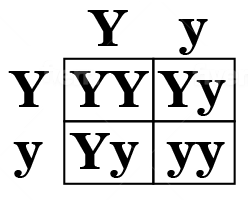
If each of the four outcomes is equally likely, what is the chance of these parents having a blue-flowered offspring?
CorrectIncorrect -
Question 20 of 22
20. Question
A Punnett square is a way to predict the genotype (gene allele combination) for specific traits for the offspring of specific parents. Each parent’s genotype is placed on one side of the square, and the resulting combinations are found in the boxes inside. Because some traits are dominant (only require one allele to be expressed in the phenotype, or appearance) and others are recessive (require two alleles to be expressed), the Punnett square can also be used to predict the chance of having an offspring with a certain trait. For this square, Y is the dominant allele for yellow flowers, and b is the recessive allele for blue flowers.
If a YY parent mates with a yy parent, what is the chance of this pair having a blue-flowered offspring?
CorrectIncorrect -
Question 21 of 22
21. Question
A Punnett square is a way to predict the genotype (gene allele combination) for specific traits for the offspring of specific parents. Each parent’s genotype is placed on one side of the square, and the resulting combinations are found in the boxes inside. Because some traits are dominant (only require one allele to be expressed in the phenotype, or appearance) and others are recessive (require two alleles to be expressed), the Punnett square can also be used to predict the chance of having an offspring with a certain trait. For this square, Y is the dominant allele for yellow flowers, and b is the recessive allele for blue flowers.
If a yy parent mates with a Yy parent, what is the chance of this pair having a blue-flowered offspring?
CorrectIncorrect -
Question 22 of 22
22. Question
A Punnett square is a way to predict the genotype (gene allele combination) for specific traits for the offspring of specific parents. Each parent’s genotype is placed on one side of the square, and the resulting combinations are found in the boxes inside. Because some traits are dominant (only require one allele to be expressed in the phenotype, or appearance) and others are recessive (require two alleles to be expressed), the Punnett square can also be used to predict the chance of having an offspring with a certain trait. For this square, Y is the dominant allele for yellow flowers, and b is the recessive allele for blue flowers.
What does the Punnett square above tell us about the ratio of dominant to recessive traits in a population?
CorrectIncorrect
- 1
- 2
- 3
- 4
- 5
- 6
- 7
- 8
- 9
- 10
- 11
- 12
- 13
- 14
- 15
- 16
- 17
- 18
- 19
- 20
- 21
- 22
- Current
- Correct
- Incorrect
